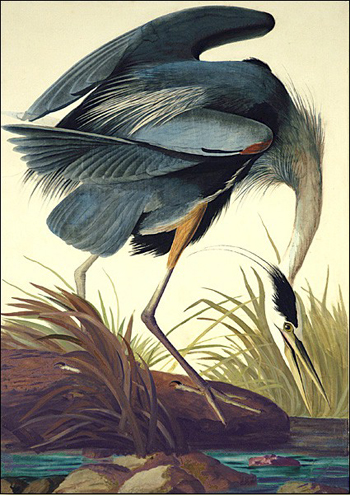| Search Art Prints | ||||||||||||||||||||
| Search Artists | ||||||||||||||||||||

|
||||||||||||||||||||
|
|
|||||||||||||||||||

Great Blue Heron

|
Great Blue Heron
John James Audubon painted ‘Great Blue Heron’ in 1821 as part of the famous “Birds of America” series. The oil painting is an awe-inspiring portrait of America’s great blue heron in its lush, marsh-like habitat. As the central focus, it stands on long legs, bending its elegant neck to gather food at the shore of the river. The water reeds emphasise the bird’s majestic height and imposing presence, while the pale background illuminates its brilliant blue hues and accentuates the textures of its feathers. The small pebbles at the forefront of the canvas work together with the landscape to create the perception of distance, adding depth and a particular lighting to the scene. The viewer might feel like a photographer kneeling down in a nearby bush in order to seize this moment.
Although John James Audubon was not the first artist to attempt to capture all of the birds in America on canvas, he most certainly was the country’s most foremost wildlife artist. The “Birds of America” series consists of 435 life size prints which have remained a standard for wildlife artists, even today. The famous namesake “Audubon Society” was established in the late 1800’s to enable the conservation of wildlife and wild lands, promoting a special interest on birds.
Analysis
Jonathan Rosen of the New York Times wrote in a review of Richard Rhodes book, ‘John James Audubon – The Birdman of America’: “Audubon created a portrait of America -- not by canvassing its political gatherings or examining its prison system, but by painting its avian inhabitants. His birds are weirdly anthropomorphic (his white pelican looks as if it might consult a pocket watch before flying) and yet they are preternaturally realistic. They look like people who have been turned into birds and might turn back at any enchanted moment, but they have the simultaneous effect of returning their viewers to the wilderness.”
‘Great Blue Heron’ by John James Audubon is part of a private collection.











